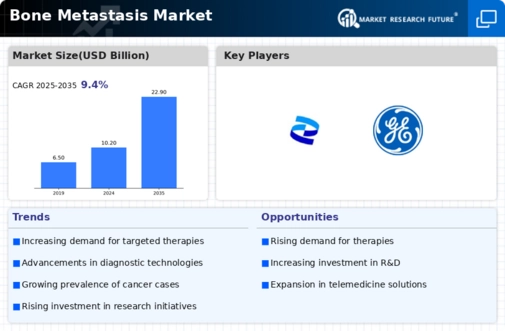Emergence of Targeted Therapies
The emergence of targeted therapies is reshaping the Bone Metastasis Market. These therapies, designed to specifically attack cancer cells while sparing healthy tissue, are gaining traction due to their improved efficacy and reduced side effects. Recent developments in monoclonal antibodies and small molecule inhibitors have shown promise in clinical trials, leading to increased interest from both clinicians and patients. The market for targeted therapies in oncology is projected to grow significantly, with estimates suggesting a compound annual growth rate of over 15% in the coming years. This shift towards precision medicine is likely to enhance treatment outcomes for patients with bone metastasis, thereby driving the overall growth of the Bone Metastasis Market. As more targeted options become available, the landscape of treatment for bone metastasis is expected to evolve.
Rising Awareness of Bone Health
The Bone Metastasis Market is benefiting from a growing awareness of bone health among patients and healthcare providers. Educational campaigns and initiatives aimed at increasing knowledge about the implications of bone metastasis are becoming more prevalent. This heightened awareness encourages early screening and proactive management of bone health in cancer patients. As a result, there is a noticeable increase in the demand for supportive therapies, such as bisphosphonates and denosumab, which are designed to strengthen bones and mitigate the effects of metastasis. In 2023, the market for supportive therapies in oncology was estimated to be around 3 billion USD, reflecting the increasing recognition of the importance of bone health in cancer care. This trend indicates that as awareness continues to rise, the Bone Metastasis Market will likely expand to meet the needs of patients.
Aging Population and Cancer Prevalence
The aging population is a critical factor influencing the Bone Metastasis Market. As individuals age, the incidence of cancer, particularly those types that commonly metastasize to bone, tends to increase. Projections indicate that by 2030, the number of individuals aged 65 and older will surpass 1 billion, leading to a corresponding rise in cancer cases. This demographic shift is likely to result in a higher demand for treatments addressing bone metastasis. Additionally, the increasing prevalence of lifestyle-related cancers, such as breast and prostate cancer, further exacerbates the situation. The Bone Metastasis Market must adapt to this growing patient population by developing effective treatment strategies and supportive care options. Consequently, the market is expected to expand in response to the needs of an aging population facing the challenges of metastatic disease.
Advancements in Diagnostic Technologies
The Bone Metastasis Market is experiencing a notable transformation due to advancements in diagnostic technologies. Enhanced imaging techniques, such as PET scans and MRI, allow for earlier detection of bone metastases, which is crucial for effective treatment planning. The integration of artificial intelligence in imaging analysis further improves diagnostic accuracy, potentially increasing the number of patients identified for treatment. As a result, the demand for targeted therapies is likely to rise, contributing to market growth. In 2023, the market for diagnostic imaging in oncology was valued at approximately 5 billion USD, indicating a robust interest in innovative diagnostic solutions. This trend suggests that as diagnostic capabilities improve, the Bone Metastasis Market will expand, driven by the need for timely and precise interventions.
Increasing Investment in Cancer Research
Investment in cancer research is a pivotal driver for the Bone Metastasis Market. Governments and private entities are allocating substantial funds to explore new treatment modalities and understand the mechanisms of metastasis. In recent years, funding for cancer research has surged, with estimates suggesting an increase of over 10% annually. This influx of capital supports the development of novel therapeutics and personalized medicine approaches, which are essential for addressing the complexities of bone metastasis. Furthermore, collaborations between academic institutions and pharmaceutical companies are fostering innovation, leading to the emergence of new treatment options. As research continues to unveil new insights, the Bone Metastasis Market is poised for growth, with a focus on translating research findings into clinical applications.


















Leave a Comment